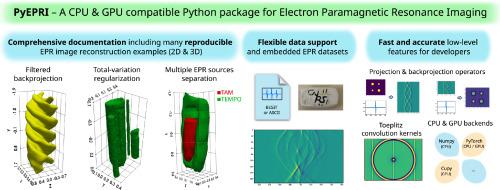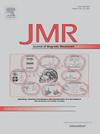PyEPRI:一个CPU和GPU兼容python包电子顺磁共振成像
IF 1.9
3区 化学
Q3 BIOCHEMICAL RESEARCH METHODS
引用次数: 0
摘要
这项工作提出了PyEPRI包,一个开源的Python包电子顺磁共振成像。PyEPRI包实现了电子顺磁共振(EPR)中涉及的低级操作,如投影和反向投影,以及为最终用户提供的高级算法,如基于总变分的EPR图像重建。该包完全用Python实现,并通过库Numpy, PyTorch和Cupy提供CPU和GPU计算能力。该软件包附带了详细的文档,包括精确的数学定义和许多可重复的演示示例和教程,使得没有编码图像处理算法的特殊专业知识的用户可以轻松入门。这个包也是高度模块化的,只依赖于标准数据类型,因此,高级用户也可以很容易地使用它来开发新的算法,同时受益于优化的计算环境和一些经过严格测试的操作符。本文章由计算机程序翻译,如有差异,请以英文原文为准。

PyEPRI: A CPU & GPU compatible python package for electron paramagnetic resonance imaging
This work presents the PyEPRI package, an open-source Python package for Electron Paramagnetic Resonance Imaging. The PyEPRI package implements low-level operators, like projection and backprojection, involved in Electron Paramagnetic Resonance (EPR) and also high-level advanced algorithms, like total variation based EPR image reconstruction, for end-users. The package is fully implemented in Python and provides both CPU and GPU computation capabilities, through the libraries Numpy, PyTorch and Cupy. This package comes with a detailed documentation, including precise mathematical definitions and many reproducible demonstration examples and tutorials, making it easy for users with no particular expertise on coding image processing algorithms to get started. This package is also highly modular and only relies on standard data types, as such, it can also be easily used by advanced users to develop new algorithms while benefiting from an optimized computing environment and some rigorously tested operators.
求助全文
通过发布文献求助,成功后即可免费获取论文全文。
去求助
来源期刊
CiteScore
3.80
自引率
13.60%
发文量
150
审稿时长
69 days
期刊介绍:
The Journal of Magnetic Resonance presents original technical and scientific papers in all aspects of magnetic resonance, including nuclear magnetic resonance spectroscopy (NMR) of solids and liquids, electron spin/paramagnetic resonance (EPR), in vivo magnetic resonance imaging (MRI) and spectroscopy (MRS), nuclear quadrupole resonance (NQR) and magnetic resonance phenomena at nearly zero fields or in combination with optics. The Journal''s main aims include deepening the physical principles underlying all these spectroscopies, publishing significant theoretical and experimental results leading to spectral and spatial progress in these areas, and opening new MR-based applications in chemistry, biology and medicine. The Journal also seeks descriptions of novel apparatuses, new experimental protocols, and new procedures of data analysis and interpretation - including computational and quantum-mechanical methods - capable of advancing MR spectroscopy and imaging.

 求助内容:
求助内容: 应助结果提醒方式:
应助结果提醒方式:


